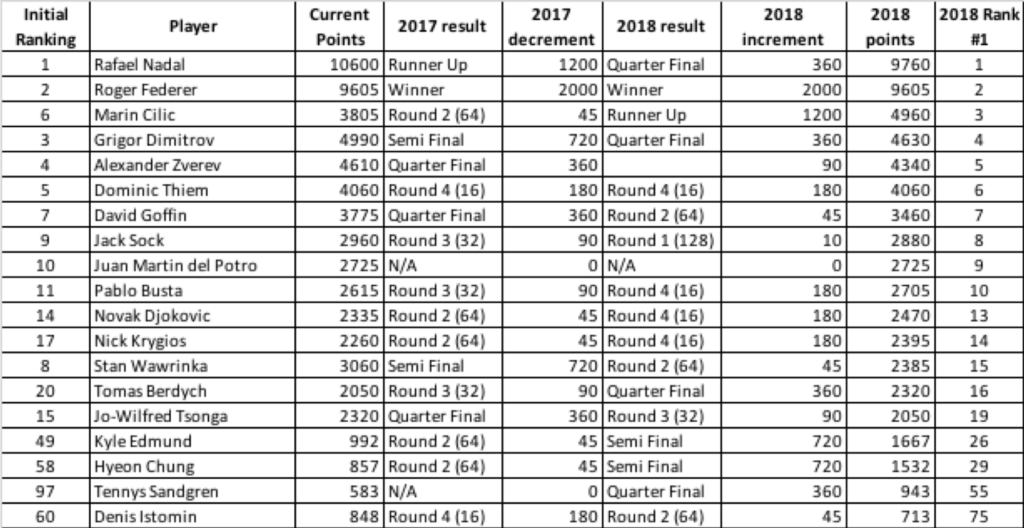
In this final article of my AusOpen 2018 series, I provide my own calculations and show the outcome of the tournament on men’s single’s rankings. The table above presents all the data. It is sorted for the 2018 rank outcome.
The table above presents all the data. It is sorted for the 2018 rank outcome.
In essence, Rafael’s quarter final performance was enough to stave off a drop from being the 2017 runner-up. Had he exited in Round 4, then Roger would reclaim the #1 rank by a mere 5 points! Fortunately, for the Spaniard, he retains a slender 155 point margin over #2 Federer. Federer’s win means he remains at #2; the top two positions being so far ahead of the pack, their incumbency is likely to continue for the next period ahead. Cilic’s runner-up result guaranteed him the #3 position, and had he won the 2018 tournament he would have still risen to #3.
Ranks 3-5 remain together as a pack, all now displaced down one rank by a single position to 4-6. David Goffin remains at #7 whilst Jack Sock and Juan Martin improved their rank by a single position. The longer list this year of lower ranked players and their movement up the ranks reflects the reality that a lot of the successful players who knocked out the higher seeded players and progressed through to the later stages of the tournament – aka the quarter finals and even semi’s – are predominantly found scattered throughout the Top 100 ranked players. Outside of the top 15:
- Previous #20 Tomas Berdych improved his 2017 round 3 exit to lose in the 2018 quarter final and thus has risen 4 spots to #16
- The inverse of Tomas is Jo-Wilfred Tsonga, who dropped 4 spots as a result of his poorer Round 3 exit this year compared to previously reaching the quarter-finals.
- Kyle Edmund was previously #49, jumps to #26, halving his rank from the top by making a semi-final appearance against eventual runner-up Marin Cilic.
- By far, the big new star and kid on the block is Korean Hyeon Chung, who entered the tournament at #58, and finishes #29 after also reaching the semi-final to go down against the champion Roger Federer.
- Tennys Sandgren, a relatively lower profile player also has climbed from #97 to #55, having made his quarter-final debut after a no-show in the 2017 Australian Open.
Whilst a lot of the newer ad younger generation players are making their presence felt on court, the 2018 season has also enabled this because a number of our perennial favourites and traditional top-seeded players were absent or competing under a form of injury or recovery from:
- Novak Djokovic – right elbow
- Andy Murray – hip
- Kei Nishikori – wrist
- Rafael Nadal – leg
Collectively these injuries have helped to create conditions conducive to Roger facing off and winning AO2018. May all players get their required time of recovery so that they can bounce back later in 2018 to create more competitive tennis experiences.


You must be logged in to post a comment.